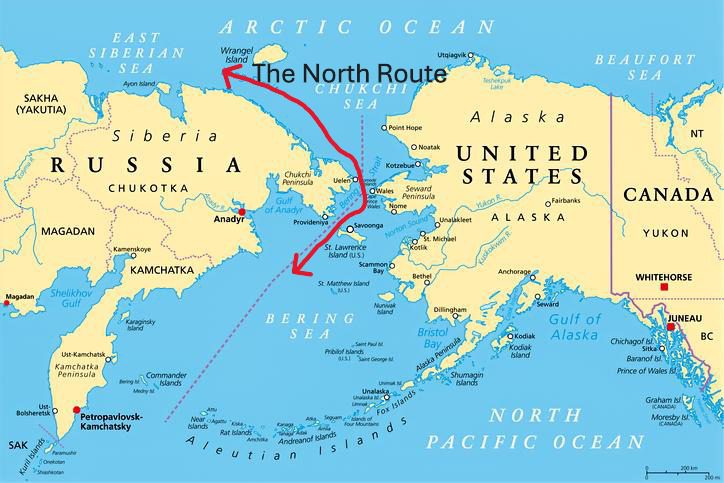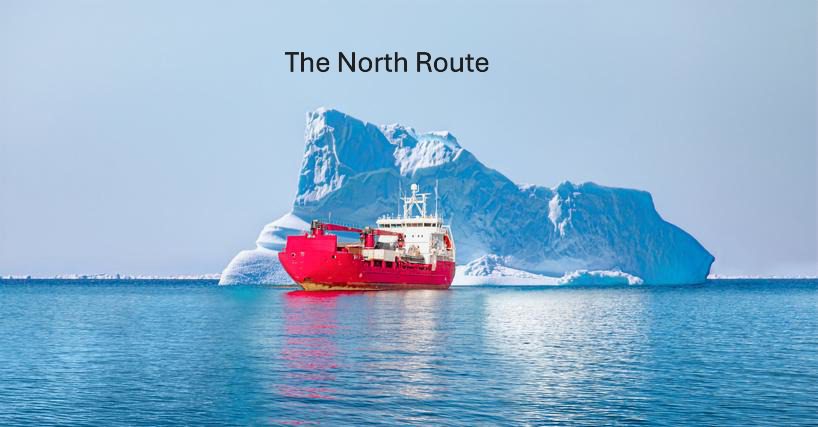#9 THE BERING STRAIT: THE ARCTIC’S NEW FRONTIER AND GLOBAL SHIPPING’S NEXT BIG THING.


🗺️ Introduction: A Narrow Gateway to a Shifting World
The Bering Strait, a shallow waterway, connects the Pacific Ocean to the Arctic Ocean. It forms a natural boundary between the easternmost point of Russia and the westernmost tip of North America (Alaska, USA). Historically a vital corridor for wildlife and Indigenous communities, this Strait is rapidly transforming. With receding Arctic sea ice, it’s becoming a major maritime passage—a sensitive geopolitical thermometer. Positioned between two global powers, it opens new frontiers for trade, resources, and strategic competition, shaping global commerce, environmental efforts, and international relations.
❄️ Geography: Cold, Concise, and Changing
- A Natural Divide: Located between Cape Dezhnev, Russia, and Cape Prince of Wales, Alaska, USA.
- Vital Maritime Link: It serves as a vital maritime link between the Arctic Ocean and the Bering Sea.
- Narrow Channel: At its slimmest, the Strait is about 82 kilometers (51 miles) wide.
- Shallow Depths: Average depths range from 30 to 50 meters (98–164 feet), with a maximum of roughly 90 meters—a critical factor for vessel draft.
- The Diomede Islands: These two islands (Big Diomede, Russia; Little Diomede, USA) sit centrally, separated by just 3.8 kilometers (2.4 miles). The international date line and the Russia-U.S. maritime border run right between them.
- Shrinking Ice Season: Historically ice-bound from January to April, ice cover is rapidly diminishing, extending the navigable season.
- Northward Flow: Predominant currents push Pacific waters into the Arctic, influencing ecosystems and ice dynamics.
Key Facts & Strategic Importance
- 🌍 The World’s Emerging Maritime Artery: The Bering Strait is rapidly transforming into a crucial gateway for new, shorter shipping routes between Asia and Europe via the Arctic. As climate change diminishes Arctic sea ice, its navigability is extending, offering significant distance and time savings. In 2024, Russia’s Northern Sea Route (which the Bering Strait serves as a key access point) saw a record 40 million tons of cargo, including 3 million tons in transit voyages, significantly surpassing previous highs.
- Growing, Yet Limited, Commercial Traffic: While still less trafficked than other global chokepoints, the volume of vessels transiting the Bering Strait is steadily increasing. From an annual average of 338 AIS-tracked ships between 2010–2019, this rose to an annual average of 576 large vessels between 2020–2023, with the highest annual count reaching 681 in 2023. This includes local supply vessels, bulk carriers for mineral exports (like zinc ore), and a growing number of icebreaking LNG carriers heading from Russian Arctic projects to Asian markets.
⚡ Energy Resource Gateway: The Arctic holds vast untapped reserves of oil and natural gas, and the Bering Strait is an increasingly vital exit point for these resources. Projects like Russia’s Yamal LNG are already utilizing the Northern Sea Route, with ambitions for year-round operation through ice-class vessels, signifying growing energy transit through this chokepoint.
🌍 Geopolitical Considerations:
- U.S.-Russia Border & Strategic Crossroads: This Strait sits directly between the U.S. (Alaska) and Russia, making it a highly sensitive international border. This adjacency fuels both historical cooperation (science, conservation) and potential tension, especially with rising regional activity.
- ⚓ Arctic Militarization & Influence: Both the U.S. and Russia are significantly boosting military presence and capabilities in the Arctic. Russia has extensively upgraded Soviet-era facilities and deployed advanced air and coastal defense systems along its vast Arctic coastline. This increased militarization raises concerns about miscalculation and competition over emerging shipping routes and resources.
- 📜 Sovereignty Disputes & “Freedom of Navigation”: While the Bering Strait itself is an international strait, the broader Arctic routes it accesses (like Russia’s Northern Sea Route) face significant disputes. Russia asserts extensive control, demanding fees and permissions for transit, viewing parts as internal waters. Other nations advocate for “freedom of navigation” through what they consider international waters—a clash adding legal and strategic complexity.
- 🤝 Indigenous Voices & Environmental Stewardship: Home to Indigenous communities on both sides, the Strait’s increasing shipping and resource activity directly impacts their traditional livelihoods. Geopolitical discussions increasingly acknowledge the vital need to integrate Indigenous perspectives in governance and environmental protection, though their voices are still often marginalized.
- 🧊 The New “Cold War” Frontier?: With its opening waters and vast resources, the Arctic—and the Bering Strait as its gateway—is sometimes seen as a new arena for great power competition. The interplay of climate change, economic opportunity, and strategic interests forms a complex, evolving landscape demanding careful international diplomacy for peace and stability.
🚢 Maritime Hazards & Modern Challenges:
- Ice, Shallows & Harsh Weather: Despite receding ice, the Bering Strait remains a profoundly challenging environment. Shifting ice, notoriously shallow depths, and extreme Arctic weather (blizzards, low visibility, freezing temperatures) pose significant navigational risks, particularly for non-ice-reinforced vessels.
- 🚨 Remote & Limited Infrastructure: Its extreme remoteness means emergency response, search-and-rescue, and pollution control infrastructure are sparse. An oil spill or major maritime incident here would be incredibly difficult to manage, with potentially catastrophic, long-lasting environmental impacts on a pristine, fragile ecosystem.
- 🚫 Regulatory Gaps & Sovereignty Issues: The Strait’s status as an international waterway, coupled with Russia’s extensive claims over the adjacent Northern Sea Route, creates regulatory ambiguities. Differing rules and enforcement capabilities can complicate international cooperation during incidents, leading to a less predictable operating environment for commercial shipping.
- 🌊 Environmental Vulnerability: Increased shipping activity amplifies risks to the Strait’s incredibly rich but delicate Arctic ecosystem. Noise pollution from vessels, the potential for devastating oil spills, and the introduction of invasive species from ballast water threaten unique marine mammals, vital fish stocks, and the subsistence livelihoods of Indigenous communities.
